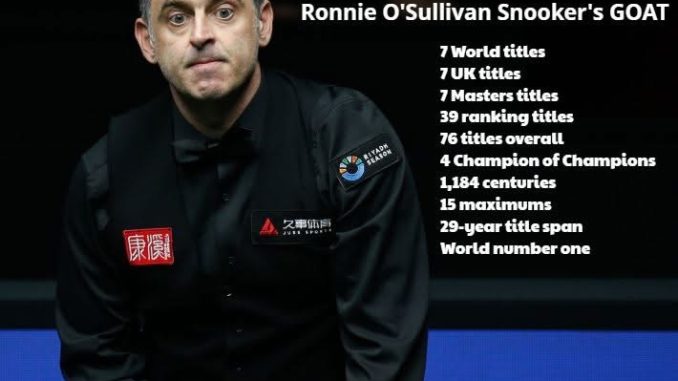
When Ronnie O’Sullivan steps into an arena, there is a hush that falls across the crowd unlike anything else in sport. He doesn’t need theatrics, pyrotechnics, or grand entrances. A cue in hand, that same calm, almost unreadable face he has worn for nearly thirty years, is enough to send a shiver of anticipation down the spine of every fan in the building. Within minutes, balls vanish from the table with surgical precision, a break builds, and before you can blink, a century is etched onto the scoreboard. It looks effortless. But behind the magic lies a story of turmoil, self-doubt, and resilience that makes O’Sullivan’s achievements all the more extraordinary.
The Prodigy Who Almost Burned Out
O’Sullivan burst onto the professional snooker scene in 1992 at the tender age of 16. Within a year, he had already claimed a ranking title, earning the nickname “The Rocket” for his lightning-fast play. By 1997, he compiled the fastest 147 break in history, a record that would endure for over two decades. To the outside world, his destiny seemed clear: he was snooker’s chosen one, a player destined to dominate for decades.
But what the public didn’t always see was the inner storm. The weight of expectation, personal struggles, and the relentless grind of the sport often left O’Sullivan questioning his future. There were times when the Rocket seriously considered walking away altogether. “I’ve hated snooker at times,” he admitted in later interviews. “I’ve been close to quitting more than once.”
His battles weren’t just with rivals across the baize. O’Sullivan has spoken candidly about his struggles with mental health, addiction, and the pressure that comes with being the face of a sport. In the early 2000s, at the very peak of his physical abilities, he wavered emotionally. Fans feared they might witness one of the game’s brightest talents flame out before his time.
Reinvention Through Resilience
What separates O’Sullivan from so many is not just natural genius but the ability to reinvent himself, both on and off the table. Guided by sports psychologists, fitness routines, and an increasing sense of perspective about life beyond the green cloth, he found ways to keep coming back stronger.
By embracing running as a passion, O’Sullivan discovered a new rhythm. The discipline of long-distance jogging gave him mental clarity, balance, and a method to combat the chaos in his head. Off the table, he also wrote books, explored punditry, and pursued other interests that allowed him to remain connected to snooker without suffocating under its demands.
Every time he returned, he did so with fresh purpose. And every comeback brought new titles, new records, and a new generation of fans who watched in awe as a man who once nearly quit evolved into a living legend.
The Greatest of All Time?
Today, O’Sullivan is widely regarded as the greatest player snooker has ever produced. With more ranking titles than any other, a record number of Triple Crown victories, and a tally of centuries that dwarfs his rivals, his place in history is cemented. Beyond statistics, though, it’s his style that sets him apart.
Where others grind, O’Sullivan glides. He plays with a fluency that makes even the most complex shots appear like second nature. Crowds come not just to see him win, but to see him play. His artistry elevates snooker from competition to performance, blurring the line between sport and art.
An Icon Beyond the Table
O’Sullivan’s journey resonates because it is not one of unbroken dominance but of vulnerability, struggle, and triumph. Fans have witnessed his lows as well as his highs, making his story more human, more relatable. He is a flawed genius, a man who once questioned whether the game was worth the pain it brought him, yet who now stands as its brightest torchbearer.
For nearly three decades, he has been the heartbeat of snooker, filling arenas, inspiring young players, and ensuring the sport remains relevant in an ever-changing entertainment landscape. In many ways, his decision not to walk away has defined modern snooker itself.
The Final Frame?
At 49, O’Sullivan shows little sign of fading. While he occasionally hints at retirement, the truth is that his love-hate relationship with the game keeps pulling him back to the table. And every time he chalks his cue, fans know they might witness something that will be replayed for decades to come.
From prodigy to survivor, from almost quitting to becoming the most decorated player the game has ever seen, Ronnie O’Sullivan’s story is proof that even in a game defined by precision, it is resilience and reinvention that make greatness truly possible.
Would you like me to make this read more like a newspaper sports feature (with quotes, subheadings, and a slightly faster pace), or keep it in this more magazine-style profile tone?
Leave a Reply